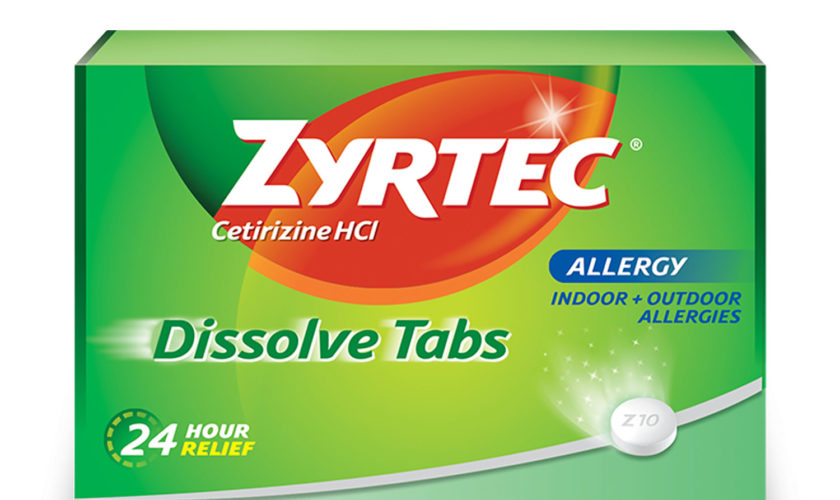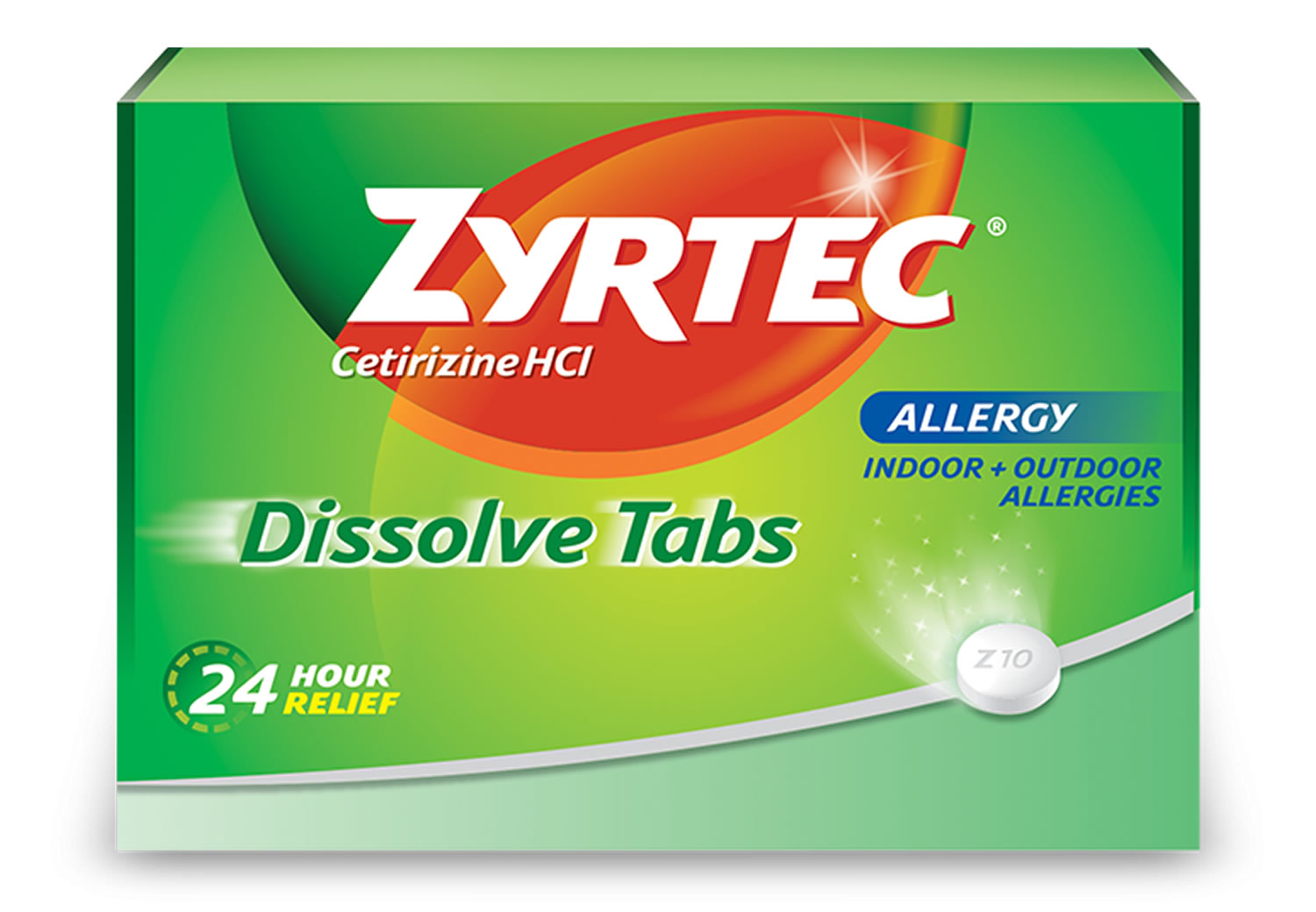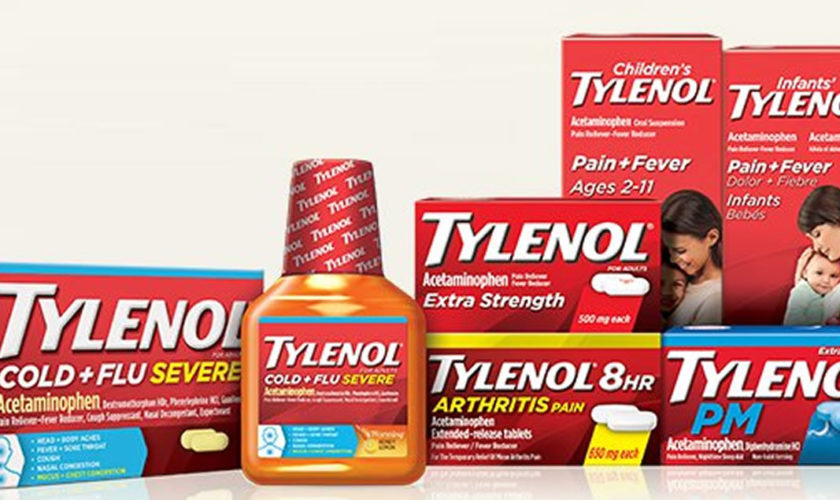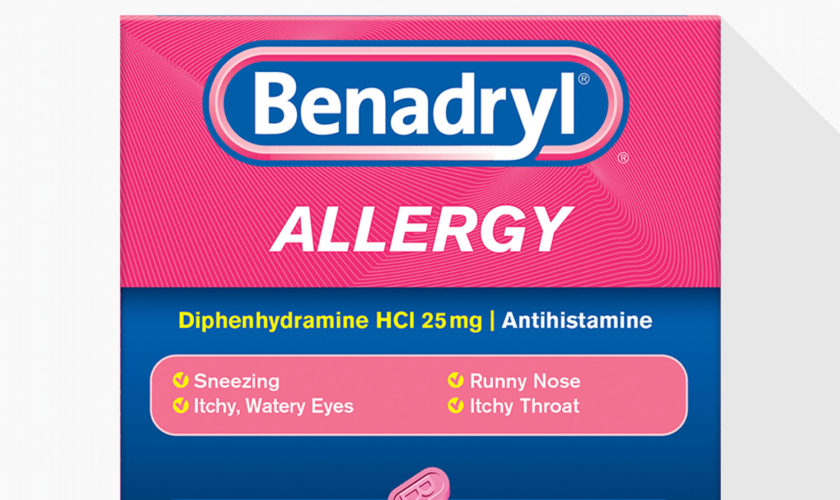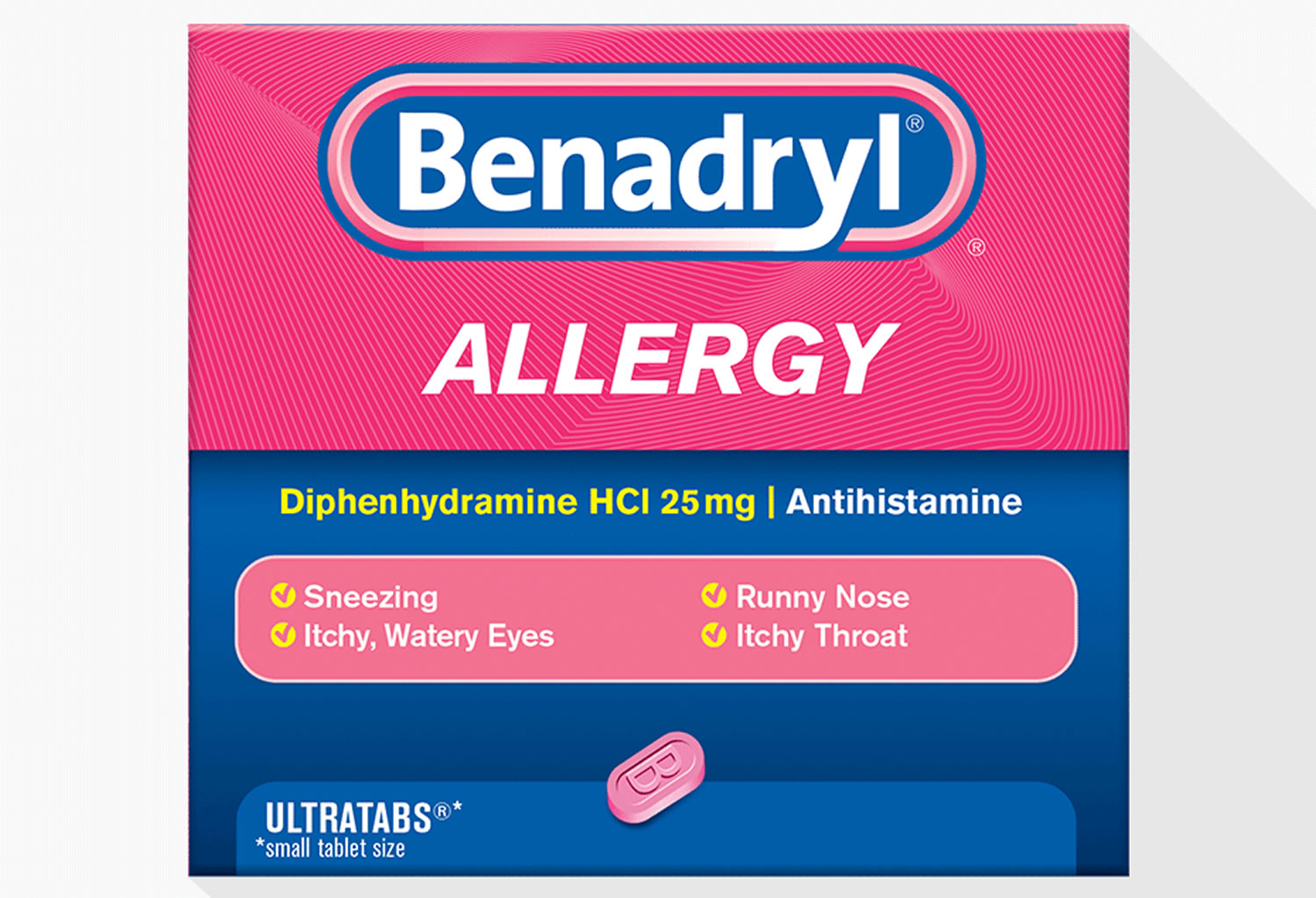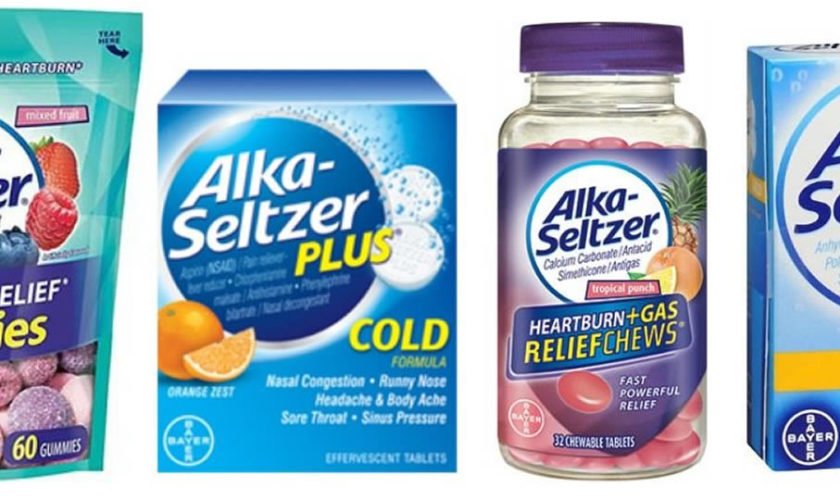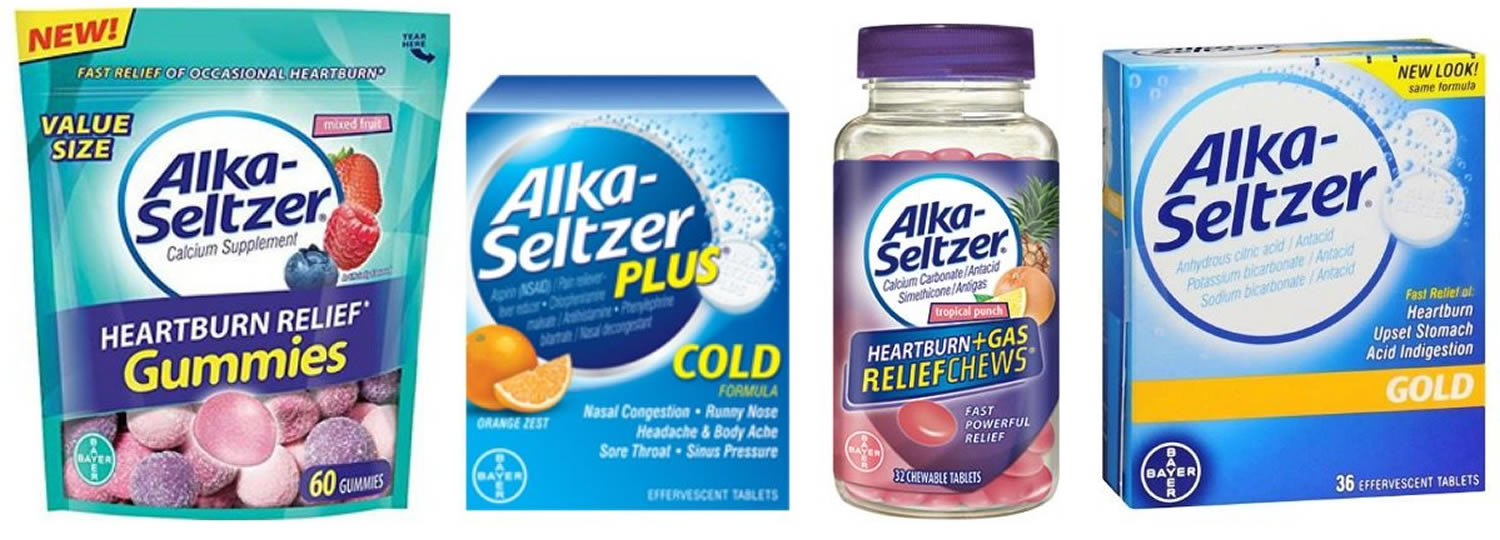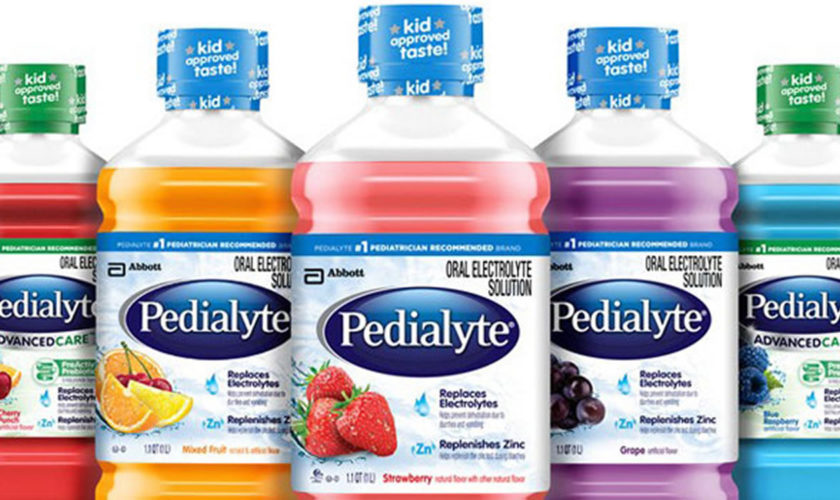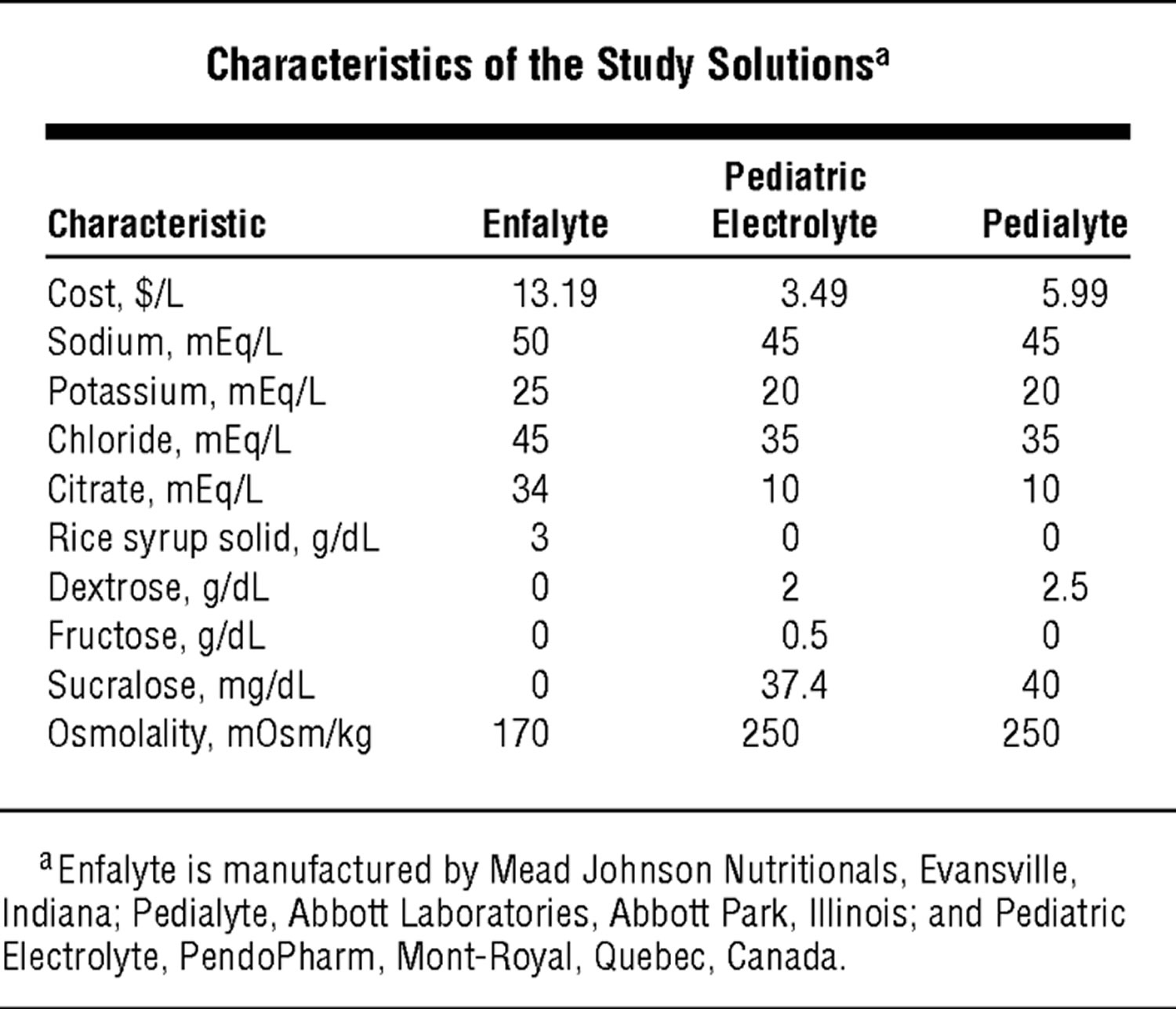What is Zyrtec
Zyrtec is an antihistamine medicine that relieves the symptoms of allergies by blocking the effects of the chemical histamine in your body. Histamine is a chemical that’s released by Mast cells in your body when an allergen is encountered that can produce symptoms of sneezing, hives, itching, watery eyes, and runny nose, also known as hypersensitivity reactions. Zyrtec’s active ingredient is a compound called Cetirizine (IUPAC name: 2-[2-[4-[(4-chlorophenyl)-phenylmethyl]piperazin-1-yl]ethoxy]acetic acid) which is a non-drowsy antihistamine 1. Zyrtec (cetirizine) was the first marketed drug from the series of second-generation antihistamines showing both minimal side effects on the central nervous system and a reduced level of cardiotoxicity 1. Zyrtec (cetirizine) is much less likely to make you feel sleepy than some other first generation or older antihistamines.
Zyrtec (cetirizine) is used to treat hay fever or allergy symptoms such as allergic conjunctivitis (red, itchy eye), eczema and hives. It’s also used for reactions to insect bites and stings and for some food allergies and the symptoms of common cold.
When you come into contact with something you’re allergic to, such as pollen, animal hair or fur, house dust or insect bites and stings, your body produces a chemical called histamine.
Usually histamine is a useful substance but in an allergic reaction it causes unpleasant symptoms including itchy, watery eyes, running or blocked nose, sneezing and skin rashes.
Zyrtec (cetirizine) blocks the effects of histamine and reduces these symptoms.
Key facts:
- It’s usual to take Zyrtec (cetirizine) once a day. Children sometimes take it twice a day.
- Zyrtec (cetirizine) is classed as a non-drowsy antihistamine, but some people still find it makes them feel quite sleepy.
- Common side effects include headache, dry mouth, feeling sick, dizziness, tummy pain and diarrhea.
- It’s best not to drink alcohol while you’re taking Zyrtec (cetirizine) as it can make you feel sleepy.
- Cetirizine is sold under the trade names Benadryl Allergy, Piriteze, Zirtec, Zyrtec, and Reactine.
Zyrtec (cetirizine) is available on prescription. You can also buy it from pharmacies and supermarkets.
Zyrtec (cetirizine) comes as tablets, capsules and as a liquid that you swallow.
Despite Zyrtec (cetirizine) is being marketed as a non-drowsy antihistamine, it may still impair your thinking or reactions. Be careful if you drive or do anything that requires you to be alert. Drinking alcohol can increase certain side effects of Zyrtec.
Tell your doctor if you regularly use other medicines that make you sleepy (such as other cold or allergy medicine, narcotic pain medicine, sleeping pills, muscle relaxers, and medicine for seizures, depression, or anxiety). They can add to sleepiness caused by Zyrtec. Call your doctor if your symptoms do not improve, if they get worse, or if you also have a fever.
How long does it take for zyrtec to work?
Cetirizine starts to work within 30 – 60 minutes after being taken. You should start to feel better within an hour.
How long should I take Zyrtec (cetirizine) for?
It depends on why you’re taking Zyrtec (cetirizine).
You may only need to take it for a short time or as a one-off dose. For example, if you have a reaction to an insect bite, you may only need to take Zyrtec (cetirizine) for a day or 2.
You may need to take Zyrtec (cetirizine) for longer if you’re taking it to prevent symptoms – for example, to stop hay fever when the pollen count is high.
Talk to your doctor or pharmacist if you’re unsure how long you need to take Zyrtec (cetirizine) for.
Is it safe to take Zyrtec (cetirizine) for a long time?
Zyrtec (cetirizine) is unlikely to do you any harm if you take it for a long time. However, it’s best to take Zyrtec (cetirizine) only for as long as you need to.
Can I drink alcohol with Zyrtec?
It’s best not to drink alcohol while you’re taking Zyrtec (cetirizine) as it can make you feel sleepy.
Is there any food or drink I need to avoid?
You can eat and drink normally while taking Zyrtec (cetirizine).
Can I drive or ride a bike with Zyrtec?
Zyrtec (cetirizine) is classed as a non-drowsy antihistamine but it’s still possible to feel sleepy after taking it.
If this happens to you, don’t drive a car or ride a bike until you feel better.
What’s the difference between Zyrtec (cetirizine) and other antihistamines?
Zyrtec (cetirizine) is known as a non-drowsy antihistamine. That’s because it’s less likely to make you feel sleepy than other, so-called sedating antihistamines such as Benadryl (diphenhydramine).
Most people prefer to take a non-drowsy antihistamine instead of a sedating one. An exception is when you want the medicine to make you sleepy, for example if you have itchy skin that’s keeping you awake.
What’s the difference between Zyrtec (cetirizine) and other non-drowsy antihistamines?
Other non-drowsy antihistamines like Loratadine, Desloratadine, Fexofenadine, Levocetirizine seem to work just as well as Zyrtec (cetirizine).
However, Zyrtec (cetirizine) seems to be more likely to make you feel sleepy than loratadine, desloratadine or fexofenadine.
Can I take Zyrtec with painkillers?
Yes, you can take Zyrtec (cetirizine) together with Tylenol (acetaminophen) or Motrin (ibuprofen).
Can I take more than one antihistamine together?
Sometimes doctors recommend that people with severe itchy skin rash take 2 different antihistamines together for a few days.
As well as taking a non-drowsy antihistamine during the day (such as Zyrtec or loratadine), your doctor may advise that you take a sedating antihistamine at night time if the itch is making it difficult to sleep.
Do not take 2 antihistamines together unless recommended by your doctor.
Can I take Zyrtec with other hay fever treatments?
Yes, it’s fine to take Zyrtec (cetirizine) together with other hay fever treatments, for example steroid nasal sprays (such as Beconase, Rhinacort Aqua and Flixonase Nasules) or eye drops.
Will Zyrtec affect my fertility?
There’s no evidence that Zyrtec (cetirizine) affects male or female fertility.
Will Zyrtec affect my contraception?
Zyrtec (cetirizine) does not affect any type of contraception including the contraceptive pill and the morning after pill.
Can lifestyle changes relieve hay fever?
It will help if you don’t spend too much time outside if the pollen count is high. Also:
Tips for when you’re outside:
- Don’t cut grass or walk on grass.
- Wear wraparound sunglasses to stop pollen getting into your eyes.
- Put Vaseline around your nostrils to help trap pollen.
- Shower and change your clothes after you’ve been outside to wash off pollen.
Tips for when you’re inside:
- Keep windows and doors shut as much as possible.
- Vacuum regularly and dust with a damp cloth.
- Don’t keep fresh flowers in the house.
- Don’t smoke or be around smoke as it makes hay fever symptoms worse.
Who can and can’t take Zyrtec
Zyrtec (cetirizine) tablets and liquid that you buy from pharmacies and supermarkets can be taken by adults and children aged 6 and older.
Children over the age of 2 can also take liquid Zyrtec (cetirizine) for hay fever and skin allergies.
Zyrtec (cetirizine) can also be taken under medical supervision by children aged 1 year and older.
Zyrtec (cetirizine) isn’t suitable for some people. Tell your doctor or pharmacist if you:
- have had an allergic reaction to Zyrtec (cetirizine) or any other medicines in the past
- have an allergy to peanuts or soya
- have an allergy to the food additives, E218 or E216
- have an intolerance to, or cannot absorb, some sugars such as lactose or sorbitol
- have liver or kidney failure
- have epilepsy or another health problem that puts you at risk of fits
- have an illness that means you’re more likely to retain urine
- are booked to have an allergy test – taking Zyrtec (cetirizine) may affect the results, so you might need to stop taking it a few days before the test
Pregnancy and breastfeeding
You can take Zyrtec (cetirizine) while you’re pregnant. However a similar antihistamine called loratadine is normally used first because there’s more information to say that it’s safe.
- Zyrtec (cetirizine) isn’t thought to be harmful during pregnancy, but as very few pregnant women have been studied, it is not possible to be certain.
Talk to your doctor about the benefits and possible harms of taking Zyrtec (cetirizine). It will also depend on how many weeks pregnant you are and the reason you need to take Zyrtec (cetirizine).
To assess the safety of cetirizine during pregnancy, a prospective observational cohort study with data from 1992 until 2006 was conducted 2. Pregnancy outcome was compared between a cohort of pregnant women exposed to cetirizine during the first trimester (n=196) and a control group not exposed to potential teratogens (n=1686). Major birth defects were not more common in the study group than in the control group 2. The investigators also compared the crude rate of spontaneous abortions of preterm deliveries and the birth weight of term newborns. This prospective observational study on cetirizine in pregnancy suggests that the use of cetirizine is relatively safe during the first trimester 2.
Zyrtec (cetirizine) and breastfeeding
It’s usually safe to take cetrizine if you’re breastfeeding as only small amounts get into breast milk.
However, speak to your doctor before taking Zyrtec (cetirizine) if your baby was premature, had a low birth weight or has other health problems.
What is zyrtec used for
Zyrtec (cetirizine) is used to temporarily relieve the symptoms of hay fever (allergy to pollen, dust, or other substances in the air) and allergy to other substances (such as dust mites, animal dander, cockroaches, and molds). These symptoms include sneezing; runny nose; itchy, red, watery eyes; and itchy nose or throat. Zyrtec (cetirizine) is also used to treat itching and redness caused by hives. However, Zyrtec (cetirizine) does not prevent hives or other allergic skin reactions.
Zyrtec (cetirizine) comes as a tablet, a chewable tablet, an extended release tablet, and a syrup (liquid) to take by mouth. It is usually taken once a day with or without food. Take Zyrtec (cetirizine) at around the same time every day. Follow the directions on the package label carefully, and ask your doctor or pharmacist to explain any part you do not understand. Take Zyrtec (cetirizine) exactly as directed. Do not take more or less of it or take it more often than directed on the package label or as recommended by your doctor.
- Do NOT use Zyrtec (cetirizine) to treat hives that are bruised or blistered, that are an unusual color, or that do not itch. Call your doctor if you have these types of hives.
Stop taking Zyrtec (cetirizine) and see your doctor if your hives do not improve during the first 3 days of your treatment or if your hives last longer than 6 weeks. If you do not know the cause of your hives, see your doctor.
If you are taking Zyrtec (cetirizine) to treat hives, and you develop any of the following symptoms, get emergency medical help right away:
- difficulty swallowing, speaking, or breathing;
- swelling in and around the mouth or swelling of the tongue;
- wheezing; drooling; dizziness; or loss of consciousness.
These may be symptoms of a life-threatening allergic reaction called anaphylaxis. If your doctor suspects that you may experience anaphylaxis with your hives, he may prescribe an epinephrine injector (EpiPen). Do not use Zyrtec (cetirizine) in place of the epinephrine injector.
Zyrtec (cetirizine) is also available in combination with pseudoephedrine (Sudafed, others). If you are taking the cetirizine and pseudoephedrine combination product, read the information on the package label or ask your doctor or pharmacist for more information.
Zyrtec dosage
Before taking Zyrtec
- tell your doctor and pharmacist if you are allergic to Zyrtec (cetirizine), hydroxyzine (Vistaril), or any other medications.
- tell your doctor and pharmacist what prescription and nonprescription medications, vitamins, nutritional supplements, and herbal products you are taking or plan to take. Be sure to mention any of the following: antidepressants, medications for anxiety, medications for mental illness, medications for seizures, other medications for cold and allergy, sedatives, sleeping pills, tranquilizers, and theophylline (Theo-24, Theolair). Your doctor may need to change the doses of your medications or monitor you carefully for side effects.
- tell your doctor if you have or have ever had kidney or liver disease.
- tell your doctor if you are pregnant, plan to become pregnant, or are breast-feeding. If you become pregnant while taking Zyrtec (cetirizine), call your doctor.
- you should know that Zyrtec (cetirizine) may make you drowsy. Do not drive a car or operate machinery until you know how this medication affects you.
- remember that alcohol can add to the drowsiness caused by this medication. Avoid drinking alcoholic beverages while taking this medication.
Cautions with other medicines
Some medicines and Zyrtec (cetirizine) interfere with each other and increase the chances of you having side effects. Check with your pharmacist or doctor if you’re taking:
- midodrine, a medicine used to treat low blood pressure
- ritonavir, a medicine used to treat HIV infection
- any medicine that makes you drowsy, gives you a dry mouth, or makes it difficult for you to pee. Taking Zyrtec (cetirizine) might make these side effects worse.
Mixing Zyrtec (cetirizine) with herbal remedies and supplements
There might be a problem taking some herbal remedies and supplements alongside Zyrtec (cetirizine) – especially ones that cause sleepiness, a dry mouth or make it difficult to urinate.
Ask your pharmacist for advice.
How and when to take Zyrtec
If you or your child have been prescribed Zyrtec (cetirizine), follow your doctor’s instructions about how and when to take it. If you’ve bought Zyrtec (cetirizine) from a pharmacy or shop, follow the instructions that come with the packet.
How much should I take?
Zyrtec (cetirizine) comes as tablets and capsules (10mg) and as a liquid medicine (labeled either 5mg/ml or 1mg/1ml).
The usual dose in adults is 10mg once daily. A 5 mg product may be appropriate for less severe symptoms.
Doses are usually lower for people with liver or kidney problems.
For children, your doctor will use your child’s weight or age to work out the right dose. If you’ve bought Zyrtec (cetirizine) for a child, follow the instructions on the packet.
Depending on their age, children may take Zyrtec (cetirizine) twice a day. In this case, try to space the doses 10 to 12 hours apart.
Zyrtec dosing information
Zyrtec Adult Dosage
Usual Adult Dose for Allergic Rhinitis
- 5 to 10 mg orally or chewed once a day
Usual Adult Dose for Urticaria
- 5 to 10 mg orally or chewed once a day
Adults 65 years and over
- 5 mg once a day; do not take more than 5 mg in 24 hours.
Dose Adjustment for Renal and Hepatic Impairment
In patients 12 years of age and older with decreased renal function (creatinine clearance 11–31 mL/min), patients on hemodialysis (creatinine clearance less than 7 mL/min), and in hepatically impaired patients, a dose of 5 mg once daily is recommended. Similarly, pediatric patients aged 6 to 11 years with impaired renal or hepatic function should use the lower recommended dose. Because of the difficulty in reliably administering doses of less than 2.5 mg (½ teaspoon) of ZYRTEC syrup and in the absence of pharmacokinetic and safety information for cetirizine in children below the age of 6 years with impaired renal or hepatic function, its use in this impaired patient population is not recommended.
How to take Zyrtec (cetirizine)
You can take Zyrtec (cetirizine) with or without food.
Always take Zyrtec (cetirizine) tablets or capsules with a drink of water, milk or juice. Swallow them whole. Do not chew them.
Zyrtec (cetirizine) liquid may be easier for children to take than tablets or capsules. The liquid medicine will come with a plastic syringe or spoon to help you measure out the right dose. If you don’t have a syringe or spoon, ask your pharmacist for one. Do not use a kitchen teaspoon as it will not give the right amount.
When to take Zyrtec (cetirizine)
You may only need to take Zyrtec (cetirizine) on a day you have symptoms, such as if you’ve been exposed to a trigger like animal hair. Or you may need to take it regularly to prevent symptoms, such as to stop hay fever during spring and summer.
What if I forget to take Zyrtec?
Take your forgotten dose as soon as you remember, unless it is nearly time for your next dose. Do not take a double dose to make up for a forgotten dose.
If you forget to give a dose to a child who is taking Zyrtec (cetirizine) twice a day, you can give the dose if it’s within 4 hours of when they should have had it. If you remember more than 4 hours after, do not give the missed dose. Instead, wait until the next dose and carry on as normal.
If you forget doses often, it may help to set an alarm to remind you. You could also ask your pharmacist for advice on other ways to help you remember to take your medicine.
What if I take too much Zyrtec?
Zyrtec (cetirizine) is generally very safe. Taking too much is unlikely to harm you or your child.
If you take an extra dose by mistake, you might get some of the common side effects. If this happens or you’re concerned, contact your doctor.
Can I take Zyrtec (cetirizine) at higher doses than on the packet?
Your doctor might suggest you or your child take a higher dose of Zyrtec (cetirizine) (up to 4 times the usual dose) for severe itchy skin rash or angioedema (swelling underneath the skin).
Taking high doses of Zyrtec (cetirizine) isn’t suitable for everyone though. Speak to your doctor if you think Zyrtec (cetirizine) isn’t working for you.
Zyrtec Children Dosage
Zyrtec (cetirizine) is usually given once or twice each day.
- Once a day: it can be given in the morning or the evening.
- Twice a day: give once in the morning and once in the evening. Ideally, these times are 10–12 hours apart, for example some time between 7 and 8 am, and between 7 and 8 pm.
Give the medicine at about the same time(s) each day so that this becomes part of your child’s daily routine, which will help you to remember.
Usual Pediatric Dose for Allergic Rhinitis:
- 6 months to 2 years: 2.5 mg orally once a day, 12 months and older may be increased to 2.5 mg orally twice a day.
- 2 to 5 years: 2.5 mg orally once a day, may be increased to 5 mg/day in 1 to 2 divided doses.
- 6 years or older: 5 to 10 mg orally or chewed once a day.
Usual Pediatric Dose for Urticaria:
- 6 months to 2 years: 2.5 mg orally once a day, 12 months and older may be increased to 2.5 mg orally twice a day.
- 2 to 5 years: 2.5 mg orally once a day, may be increased to 5 mg/day in 1 to 2 divided doses.
- 6 years or older: 5 to 10 mg orally or chewed once a day.
What if my child is sick (vomits)?
- If your child is sick less than 30 minutes after having a dose of Zyrtec (cetirizine), give them the same dose again.
- If your child is sick more than 30 minutes after having a dose of Zyrtec (cetirizine), you do not need to give them another dose. Wait until the next normal dose.
If your child is sick again, seek advice from your doctor, pharmacist or hospital. They will decide what to do based on your child’s condition and the specific medicine involved.
What if I forget to give it?
If you normally give it once a day in the morning
- Give the missed dose when you remember during the day.
If you normally give it once a day in the evening
- If you remember before bedtime, give the missed dose. If you remember after this, you do not need to wake your child up to give them the missed dose. You can give the missed dose in the morning.
If you normally give it twice a day
- If you remember up to 4 hours after you should have given a dose, give your child the missed dose. For example, if you usually give a dose at about 7 am, you can give the missed dose at any time up to 11 am. If you remember after that time, do not give the missed dose. Wait until the next normal dose.
What if I give too much?
Zyrtec (cetirizine) is generally a safe drug, and you are unlikely to do harm if you give your child an extra dose of Zyrtec (cetirizine) by mistake. If you are worried that you may have given your child too much, contact your doctor or local pharmacist. Have the medicine packet with you if you telephone for advice.
Are there any possible side-effects?
You use medicines to make your child better, but sometimes they have other effects that you don’t want (side-effects).
- If your child gets palpitations (they may feel a fluttery feeling in chest or say that their heart is racing), contact your doctor straight away or take your child to hospital.
Other side-effects you need to know about:
- Your child may feel sleepy, drowsy or sluggish after taking cetirizine. This can last for a few hours, so it may be better to give cetirizine in the evening rather than the morning.
- Your child may get a dry mouth. Eating citrus fruits (e.g. oranges) or taking sips of water may help.
- Your child’s eyesight may be blurred (fuzzy).
- Your child may have constipation (difficulty doing a poo, or doing a poo less often than usual). Encourage them to drink plenty of fluid and to eat foods that contain fiber (e.g. wholemeal foods, fruit and vegetables). If this is still a problem after 2 weeks, contact your doctor.
- Your child may find that they urinate (do a wee) less often, or have difficulty doing a wee.
- Your child may feel light headed and faint (dizziness). Encourage them not to stand up too quickly, and to sit or lie down if they feel dizzy.
- They may get headaches when they first start taking cetirizine.
There may, sometimes, be other side-effects that are not listed above. If you notice anything unusual and are concerned, contact your doctor.
Can other medicines be given at the same time as Zyrtec (cetirizine)?
- You can give your child medicines that contain paracetamol or ibuprofen, unless your doctor has told you not to.
- Check with your doctor or pharmacist before giving any other medicines to your child. This includes herbal or complementary medicines.
Is there anything else I need to know about Zyrtec (cetirizine)?
- If your child continues to get symptoms of hay fever, contact your doctor. They may consider other treatments.
- Symptoms of eczema and asthma may get worse during the hay fever season. If this happens, contact your doctor.
Where should I keep this medicine?
- Keep the medicine in a cupbord, away from heat and direct sunlight. It does not need to be kept in the fridge.
- Make sure that children cannot see or reach the medicine.
- Keep the medicine in the container it came in.
Zyrtec side effects
Like all medicines, Zyrtec (cetirizine) can cause side effects although not everyone gets them.
The most commonly reported side effects include somnolence, dizziness, and headache.
Common side effects
Common side effects of Zyrtec (cetirizine) happen in more than 1 in 100 people. Talk to your doctor or pharmacist if these side effects bother you or don’t go away:
- feeling sleepy and tired
- drowsiness
- excessive tiredness
- headache
- dry mouth
- feeling sick or dizzy
- stomach pain
- diarrhea
- vomiting
- sore throat
- cold-like symptoms of the nose
- itch or rash
- tingling in the hands and feet
- feeling agitated
Children are more likely to get diarrhea or cold-like symptoms of the nose than adults.
Nervous system
- Very common (10% or more): Somnolence (up to 14.3%), headache (up to 14%)
- Common (1% to 10%): Dizziness
- Frequency not reported: Altered sense of taste, paresthesia, hypertonia, tremor, abnormal coordination/incoordination, ataxia, hyperesthesia, hyperkinesia, hypoesthesia, migraine, paralysis, twitching, parosmia, taste loss/perversion
- Postmarketing reports: Convulsions, dysgeusia, dyskinesia, dystonia, syncope, amnesia, vertigo, memory impairment
Gastrointestinal
- Common (1% to 10%): Dry mouth, nausea, diarrhea, vomiting, abdominal pain
- Uncommon (0.1% to 1%): Dyspepsia
- Frequency not reported: Tongue disorder, constipation, flatulence, increased salivation, aggravated tooth caries, eructation, gastritis, hemorrhoids, melena, rectal hemorrhage, stomatitis/ulcerative stomatitis, tongue discoloration/edema, enlarged abdomen
Respiratory
- Common (1% to 10%): Pharyngitis, rhinitis, coughing, epistaxis
- Frequency not reported: Dyspnea, respiratory disorder, bronchospasm, upper respiratory tract infection, dysphonia, bronchitis, hyperventilation, increased sputum, pneumonia, sinusitis, nasal polyp
Other
- Common (1% to 10%): Fatigue
- Frequency not reported: Earache, tinnitus, fever, pain, rigor, thirst, deafness, ototoxicity, accidental injury, face edema, leg edema, malaise
- Postmarketing reports: Asthenia, stillbirth
Psychiatric
- Common (1% to 10%): Insomnia
- Frequency not reported: Nervousness, impaired concentration, confusion, decreased libido, abnormal thinking, anxiety, depersonalization, emotional lability, euphoria, paroniria, sleep disorder
- Postmarketing reports: Agitation, aggression/aggressive reaction, depression, hallucination, tic, suicidal ideation/suicide
Musculoskeletal
- Very rare (less than 0.01%): Myelitis
- Frequency not reported: Back pain, myalgia, arthralgia, bone disorder/fracture, leg cramps, arthritis, arthrosis, muscle weakness
Dermatologic
- Frequency not reported: Pruritus/intense itching, increased sweating, acne, alopecia, bullous eruption, dermatitis, dry skin, eczema, erythematous rash, furunculosis, hyperkeratosis, hypertrichosis, maculopapular rash, photosensitivity/photosensitivity toxic reaction, purpura, seborrhea, skin disorder/nodule
- Postmarketing reports: Rash, urticaria, angioneurotic edema, fixed drug eruption, acute generalized exanthematous pustulosis
Ocular
- Frequency not reported: Eye abnormality, periorbital edema, abnormal vision, eye pain, conjunctivitis, ptosis, visual field defects, blindness, glaucoma, ocular hemorrhage, xerophthalmia, periorbital edema/eye swelling
- Postmarketing reports: Accommodation disorder/loss of accommodation, blurred vision, oculogyration, orofacial dyskinesia
Genitourinary
- Frequency not reported: Polyuria, urinary retention, urinary tract infection, dysmenorrhea, hematuria, micturition frequency, urinary incontinence, female breast pain, intermenstrual bleeding, leukorrhea, menorrhagia, vaginitis
- Postmarketing reports: Dysuria, enuresis
Cardiovascular
- Frequency not reported: Flushing, palpitations, tachycardia, edema/general edema, chest pain, cardiac failure, hypertension, hot flashes, peripheral edema, pallor
- Postmarketing reports: Severe hypotension
Metabolic
- Frequency not reported: Increased appetite, anorexia, increased weight, dehydration, diabetes mellitus
Hepatic
- Frequency not reported: Reversible transaminase elevations
- Postmarketing reports: Abnormal hepatic function (increased transaminases, alkaline phosphatase, GGT, bilirubin), cholestasis, hepatitis
Hypersensitivity
- Frequency not reported: Allergic reactions/delayed allergic reactions
- Postmarketing reports: Hypersensitivity, anaphylactic shock
Hematologic
- Frequency not reported: Lymphadenopathy
- Postmarketing reports: Thrombocytopenia, hemolytic anemia
Renal
- Frequency not reported: Cystitis
- Postmarketing reports: Glomerulonephritis
Serious side effects
It’s rare to have a serious side effect with Zyrtec (cetirizine).
Tell your doctor straight away if you have:
- bruising or bleeding that’s more than normal
- difficulty breathing or swallowing
Zyrtec (cetirizine) may cause other side effects. Call your doctor if you have any unusual problems while taking this medication.
Serious allergic reaction
In rare cases, it’s possible to have a serious allergic reaction to Zyrtec (cetirizine). A serious allergic reaction is an emergency. Contact a doctor straight away if you think you or someone around you is having a serious allergic reaction.
The warning signs of a serious allergic reaction are:
- getting a skin rash that may include itchy, red, swollen, blistered or peeling skin
- wheezing
- tightness in the chest or throat
- having trouble breathing or talking
- swelling of the mouth, face, lips, tongue, or throat
These are not all the side effects of Zyrtec (cetirizine). For a full list see the leaflet inside your medicines packet.
How to cope with side effects
What to do about:
- feeling sleepy – try a different non-drowsy antihistamine. If this doesn’t help, talk to your doctor.
- feeling sick – stick to simple meals and don’t eat rich or spicy food
- headache – take an everyday painkiller like paracetamol or ibuprofen
- dry mouth – chew sugar-free gum or suck sugar-free sweets
- diarrhea – drink plenty of water in small, frequent sips. It may also help to take oral rehydration solutions like pedialyte. You can buy these from a pharmacy or supermarket to prevent dehydration. Don’t take any other medicines to treat diarrhea without speaking to a pharmacist or a doctor.
Human Toxicity Reports
In a controlled study of 1 week’s duration in patients 6-11 months of age, those receiving cetirizine exhibited greater irritability/fussiness than those receiving placebo. In a controlled study in patients 12 months of age and older, insomnia occurred more frequently with cetirizine than with placebo (9 vs 5.3%, respectively). In those who received 5 mg or more daily, fatigue occurred in 3.6 or 1.3% and malaise in 3.5 or 1.8% of those receiving cetirizine or placebo, respectively 3.
Fatigue or dizziness occurred in 5.9 or 2%, respectively, of patients 12 years of age and older receiving cetirizine, whereas these effects occurred in 2.6 or 1.2%, respectively, of patients receiving placebo 4. Headache was reported in more than 2% of patients 12 years of age and older receiving the drug; however, headache occurred more frequently in patients receiving placebo. In clinical trials in patients 6-11 years of age, headache occurred in 11, 14, or 12.3% of patients receiving 5-mg doses, 10-mg doses, or placebo, respectively. Abnormal coordination, ataxia, confusion, abnormal thinking, agitation, amnesia, anxiety, depersonalization, depression, emotional lability, euphoria, impaired concentration, insomnia, sleep disorders, nervousness, paroniria, dysphonia, asthenia, malaise, pain, hyperesthesia, hypoesthesia, hyperkinesia, hypertonia, migraine headache, myelitis, paralysis, paresthesia, ptosis, syncope, tremor, twitching, and vertigo have been reported in less than 2% of patients 12 years of age and older and children 6-11 years of age receiving cetirizine hydrochloride; however, a causal relationship to the drug has not been established. Aggressive reaction, seizures, hallucinations, suicidal ideation, and suicide have been reported rarely during postmarketing surveillance 4.
The most frequent adverse effect in patients 12 years of age and older reported during cetirizine therapy is somnolence, occurring in 11, 14, or 6% of patients receiving 5-mg doses, 10-mg doses, or placebo, respectively 4. Overall, somnolence has been reported in 13.7 or 6.3% of patients receiving cetirizine or placebo, respectively. In addition, in clinical trials in patients 6-11 years of age, somnolence occurred in 1.9, 4.2, or 1.3% of patients receiving 5-mg doses, 10-mg doses, or placebo, respectively. Discontinuance of therapy because of somnolence has been reported in 1 or 0.6% of patients receiving cetirizine or placebo, respectively.1 3 In patients 6-24 months of age, somnolence occurred with essentially the same frequency in those who received cetirizine versus placebo.
Adverse effects reported in 1% or more of patients 12 years of age and older with seasonal allergic rhinitis who received extended-release tablets of cetirizine hydrochloride in fixed combination with pseudoephedrine hydrochloride (Zyrtec-D) included insomnia, dry mouth, fatigue, somnolence, pharyngitis, epistaxis, accidental injury, dizziness, and sinusitis 4.
A case of recurrent acute hepatitis related to the use of cetirizine has been described in a 26-year-old man who was hospitalized with a week-long history of weakness, nausea, anorexia, and hyperchromic urine, which had developed after 6 days of therapy with oral cetirizine 10 mg/day for allergic rhinitis 5. Admission laboratory testing revealed evidence of acute hepatitis and seropositivity for liver-kidney microsome antibodies. Liver biopsy findings of diffuse portal tract and lobular inflammation with a prominent eosinophilic infiltrate were consistent with drug-related hepatitis. The patient was discharged after one week of treatment with tocopherol and glutathione. Three months after discharge, transaminase levels were normal. At 6 months, seropositivity for liver-kidney microsome antibodies was still present, but considerably less intense. The patient had suffered 2 previous episodes of “acute hepatitis of unknown origin,” and both had occurred after cetirizine use 5. The study authors indicated cetirizine as the probable cause of acute hepatitis, and the positivity for liver-kidney microsome antibodies is suggestive of an autoimmune mechanism for liver damage. This is the fourth reported case of acute hepatitis associated with cetirizine and the second in which liver-kidney microsome antibodies have been documented. Although cetirizine is considered to have low potential for severe hepatic toxicity, the possibility that it can provoke autoimmune-mediated hepatotoxicity should be considered 5.
In U.S. clinical trials, transient reversible hepatic transaminase elevations were observed in <2% of patients during cetirizine therapy 6. A case of cetirizine-induced cholestasis in a 28-year-old man with no previous hepatobiliary disease after a 2-year period of taking cetirizine on a daily basis is reported. The treatment of this patient included the use of ursodeoxycholic acid, as well as hydroxyzine, for symptomatic relief of pruritus. In light of the patient’s clinical and biochemical improvement while using hydroxyzine, it appears that the hepatic metabolism of hydroxyzine to metabolites, including cetirizine, is involved in the pathogenesis of this particular case of drug-induced hepatotoxicity. Cetirizine should be considered as a potential cause of drug-induced cholestasis 6.
The case of a 29-yr-old woman with pruritus sine materiae who was receiving treatment with oral tablets of 20 mg of cetirizine hydrochloride daily, after which she developed generalized chronic urticaria associated with cetirizine administration is presented 7. The patient was admitted for diagnostic purposes, and cetirizine was stopped on admission. Surprisingly, the patient’s urticarial lesions resolved completely within 4 days. Subsequently, the patient showed a pseudoallergic response to a cellular antigen stimulation test performed with cetirizine. The patient was rechallenged with cetirizine 7 wk after discharge. The patient developed a generalized wheal reaction 15 min after an oral dose of 5 mg of cetirizine 7.
Dystonia is a movement disorder that causes involuntary contractions of the muscles. Dystonia can affect just one muscle, a group of muscles, or all of the muscles. The most common cause of acquired dystonia in childhood is drugs. Cetirizine is widely used for allergic disorders in childhood. It is without central nervous system side effects at recommended dosages. A case of cetirizine-induced acute acquired dystonia whose symptoms completely resolved after the discontinuation of the drug is reported 8.
Cetirizine can cause oculogyric crisis, especially in the pediatric age group according to a retrospective, observational case series and case reports that were collected from the National Registry of Drug-Induced Ocular Side Effects (Casey Eye Institute, Portland, Oregon) 9.
Zyrtec overdose
In case of overdose, call the poison control helpline at 1-800-222-1222. Information is also available online at https://www.poisonhelp.org/help. This is a free and confidential service. All local poison control centers in the United States use this national number. You should call if you have any questions about poisoning or poison prevention. It does NOT need to be an emergency. You can call for any reason, 24 hours a day, 7 days a week.
Symptoms of Zyrtec overdose may include:
- restlessness
- irritability
- drowsiness
A case of a 18-year-old female with the history of anorexia for 2 years, who was admitted to a Clinic of Toxicology because of suicidal attempt with use of cetirizine is presented 10. The laboratory results revealed metabolic acidosis with the pH 7.13; pO2 88 mm Hg; pCO2 36 mm Hg; HCO3 12.0 mmol/L; BE (-)17 mmol/L; SO2 100% and hypokalemia (K+ 3.1 mmol/L). On physical examination blood pressure was 70/40 mm Hg, heart rate was 36-40 beats/min. Convulsions were observed. After about two hours of intensive treatment there was a cardiac arrest in the form of ventricular fibrillation. The resuscitation procedures which lasted for over 2.5 hours were ineffective 10.. The high dose (270 mg) of cetirizine as well as anorexia and hypokalemia could have been the cause of the unique character of the symptoms in this case. Further investigations should be carried out to confirm the safety of cetirizine in the conditions of massive intoxication and with coexistence of other risk factors 10.
In one adult patient who took 150 mg of Zyrtec, the patient was somnolent but did not display any other clinical signs or abnormal blood chemistry or hematology results. In an 18 month old pediatric patient who took an overdose of Zyrtec (approximately 180 mg), restlessness and irritability were observed initially; this was followed by drowsiness 11.
Few reports exist on the result of cetirizine overdose in children 12. A case report of a 12 fold overdose of cetirizine in a four-year-old-boy (weight 20 kg) who accidentally ingested 60 mg. Vomiting was induced 1 1/2 hour after ingestion in the out-patient clinic at the local hospital because of severe drowsiness. Due to continued lethargy he was transferred to the referral pediatric department for further observation. He was fully recovered after five to six hours without any treatment 12. Electrocardiographic monitoring was normal. Five incidents of cetirizine overdose in children have been reported previously. Drowsiness and sedation were observed, but no other side effects 12. The risk of cardiac events related to an overdose of cetirizine is extremely small. A certain degree of sedation is to be expected.
A cardiac condition called Torsades de pointes has been associated hypokalemia. A case of a dialysed patient with chronic renal failure who had symptomatic episodes of torsades de pointes in the context of hypokalemia and cetirizine overdose has been described 13.
- Handing KB, Shabalin IG, Szlachta K, Majorek KA, Minor W. Crystal structure of equine serum albumin in complex with cetirizine reveals a novel drug-binding site. Molecular immunology. 2016;71:143-151. doi:10.1016/j.molimm.2016.02.003. https://www.ncbi.nlm.nih.gov/pmc/articles/PMC4800003/[↩][↩]
- Weber-Schoendorfer C, Schaefer C; Reprod Toxicol 26 (1): 19-23 (2008). https://www.sciencedirect.com/science/article/pii/S0890623808001238[↩][↩][↩]
- American Society of Health System Pharmacists; AHFS Drug Information 2009. Bethesda, MD. (2009), p. 27-8[↩]
- American Society of Health System Pharmacists; AHFS Drug Information 2009. Bethesda, MD. (2009), p. 27[↩][↩][↩][↩]
- Pompili M et al; Ann Pharmacother 38 (11): 1844-7 (2004). Available from, as of July 24, 2009 https://www.ncbi.nlm.nih.gov/pubmed/15383643[↩][↩][↩]
- Fong DG et al; J Clin Gastroenterol 31 (3): 250-3 (2000). Available from, as of July 6, 2009 https://www.ncbi.nlm.nih.gov/pubmed/11034010[↩][↩]
- Karamfilov T et al; Br J Dermatol 140 (5): 979-80; 1999 https://onlinelibrary.wiley.com/doi/full/10.1046/j.1365-2133.1999.02849.x[↩][↩]
- Esen I et al; Pediatr Emerg Care 24 (9): 627-8 (2008). Available from, as of July 10, 2009 https://www.ncbi.nlm.nih.gov/pubmed/18797375[↩]
- Fraunfelder FW, Fraunfelder FT; Am J Ophthalmol 137 (2): 355-7;2004 https://www.ncbi.nlm.nih.gov/pubmed/14962433[↩]
- Chodorowski Z et al; Przegl Lek 61 (4): 433-4 (2004). Available from, as of July 6, 2009 https://www.ncbi.nlm.nih.gov/pubmed/15521622[↩][↩][↩]
- US Natl Inst Health; DailyMed. Current Medication Information for Zyrtec – cetirizine hydrochloride https://dailymed.nlm.nih.gov/dailymed/index.cfm[↩]
- Hansen JJ et al; Ugeskr Laeger 160 (41): 5946-7 (1998). Available from, as of July 24, 2009 https://www.ncbi.nlm.nih.gov/pubmed/9786037[↩][↩][↩]
- Renard S et al; Arch Mal Coeur Vaiss 98 (2): 157-61 (2005). Available from, as of July 24, 2009 https://www.ncbi.nlm.nih.gov/pubmed/15787309[↩]






